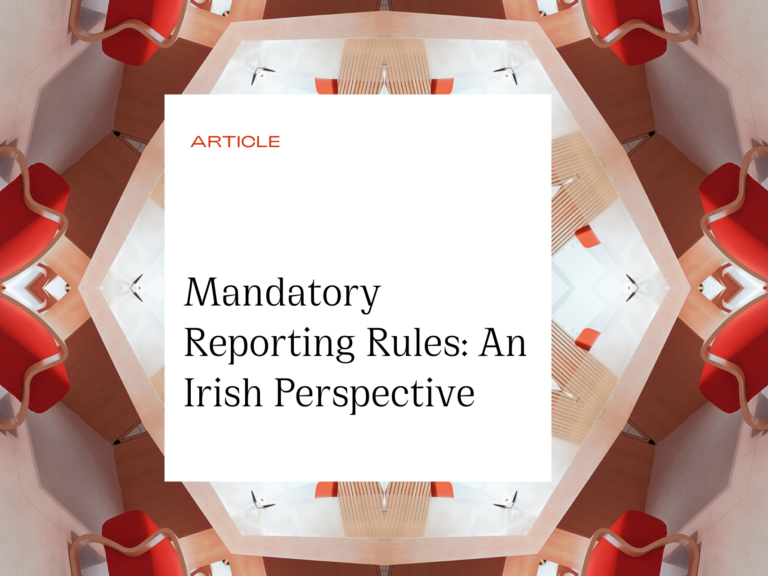
Asset Management and Investment Funds Legal and Regulatory Update March 2020
Welcome to the March edition of our Asset Management and Investment Funds Legal and Regulatory Update.
This issue we consider a number of Central Banks updates including: its thematic review of liquidity risk management in UCITS, the proposal to create 6 new PCF roles aligned to the CP86 managerial functions, and the Central Bank’s review of its PRISM supervisory framework. We also note ESMA’s publication of the official translations of its guidelines on stress test scenarios for Money Market Funds
If you would like to discuss any of the topics covered, please feel free to contact a member of our team.
UCITS Liquidity Risk Management Thematic Review – Central Bank Sets Filing Deadline
On 4 March, the Central Bank advised UCITS fund management companies that the liquidity risk management questionnaire was available for completion on the Central Bank’s Online Reporting System (“ONR”). The questionnaire must be completed by 16:00hrs on Wednesday, 25 March 2020. The Central Bank has stated that it is not in a position to extend the deadline and it will not be possible to submit the questionnaire after this date.
The questionnaire return is called “ESMA Common Supervisory Action on UCITS Liquidity Risk Management” and is available in the Analytics and Risk Section of the ONR. All sections of the return must be completed and cell F5 on the cover tab must read “valid”. Invalid returns will be rejected by the ONR. Details on the naming convention are contained on the ONR system.
The Central Bank recommends that UCITS fund management companies complete the questionnaire at the earliest opportunity to ensure that any issues arising on submission can be resolved as soon as possible. Queries should be directed to: [email protected]
The Central Bank is requesting that this correspondence be brought to the attention of all board members and the board of directors of each UCITS fund management company is reminded of its responsibility to ensure that the questionnaire is completed and submitted in the timeframe allowed.
For more information on the Central Bank’s thematic review of UCITS’ liquidity management, please see our previous update.
Designated Persons: Central Bank to Create Six PCF Roles Aligned to CP86 Managerial Functions
On 25 February, the Central Bank published a notice of intention to remove the existing Designated Person (“DP”) pre-approval controlled function (“PCF-39”) and replace it with six new pre-approval controlled functions (“PCF”), each aligned to the specific managerial functions set out in the Central Bank’s Fund Management Company Guidance (commonly referred to as “CP86”).
The new PCF designations are:
- PCF-39A: DP with responsibility for Capital and Financial Management
- PCF-39B: DP with responsibility for Operational Risk Management
- PCF-39C: DP with responsibility for Fund Risk Management
- PCF-39D: DP with responsibility for Investment Management
- PCF-39E: DP with responsibility for Distribution
- PCF-39F: DP with responsibility for Regulatory Compliance
The changes will be introduced by amendment to the existing regulations designating PCFs (and controlled functions). The Central Bank has advised that DPs in situ on the date the amended regulations come into effect will not be required to seek the approval of the Central Bank to continue to perform the new PCF roles. However, fund boards will be required to review their PCF assessments conducted under section 21 of the Central Bank Reform Act 2010 in respect of the in situ DPs and submit confirmation of this assessment to the Central Bank.
Fund boards must conduct these assessments and provide their confirmations to the Central Bank within six weeks of the amended regulations taking effect. Should the DP change after the new PCF roles have been introduced by the amended regulations, he/she will be required to seek the Central Bank’s prior approval in writing to that appointment by means of a new IQ submission.
Three new categories of PCF are also being introduced, one of which PCF 49: Chief Information Officer, may be relevant to fund companies depending on their PRISM impact rating and if IT is a key enabler or core element of their business model.
Actions
Once the amended regulations take effect, the fitness and probity assessment conducted by the fund board prior to the appointment of a DP will have to be reviewed and a confirmation provided to the Central Bank that the assessment has been carried out within the six week timeframe. The exact timings and specifics of the confirmation remain unclear. However, it is likely that a refresh of the fitness and probity assessments for the DPs will need to be done (notwithstanding that the annual PCF confirmations will have been filed by 28 February) and these subsequent confirmations will be required during Spring/Summer 2020.
The Central Bank is inviting comments from stakeholders on this proposal until 26 March 2020. Comments should be submitted by email to: [email protected].
Central Bank’s PRISM Impact Review
The Central Bank is reviewing its PRISM supervisory framework and as part of this work conducted a PRISM Impact Review (the “Review”).
The Review examined the prudential impact models across a number of sectors, including the Asset Management and Fund Service Provider sectors, and has resulted in the Central Bank making revisions to:
- the number of prudential impact models; and
- the metrics and their weightings used in many of the prudential impact models.
A key driver of impact under the Central Bank’s former PRISM Impact models was entity size. However, the Central Bank’s Review has demonstrated that new metrics are required to enhance the Central Bank’s evaluation of a firm’s impact. Therefore, new metrics are being introduced that are designed to capture other dimensions of impact including; substitutability, connectivity and the scale and spread of regulated entity failure.
The financial service providers (“FSPs”) in the sectors included in the Review will be supervised according to their impact categorisation as determined by the revised prudential impact models in 2020. The Central Bank has stated that it will write to FSPs included in the affected prudential impact models to provide information on their impact categorisation. The Central Bank has indicated that it will communicate with the Asset Management and Fund Service Provider sectors during H1 2020.
Additionally, the Central Bank has contacted certain FSPs requesting additional data to support the implementation of the new PRISM impact models. The Central Bank had previously gathered data from FSPs in July 2018. The current data request takes two forms:
- a retrospective request to build up the historic data set; and
- a scheduled return which will refresh impact data on an ongoing basis.
To facilitate this request the Central Bank has scheduled a new mandatory return for all firms called: “New PRISM Impact Metric Data Report AMIB”. This return will be available via the Central Bank’s Online Reporting System (“ONR”) and follows the same format as the initial data request in July 2018.
The first return should be submitted via the ONR on or before 26 March 2020.
The schedule for the new return is as follows:
- the first return (due 26 March 2020) is a one off month by month request that seeks to close the data gap between the first return in July 2018 and 31 December 2019;
- the next return (due 28 July 2020) will require firms to submit data for end Q1 and end Q2 2020; and
- from the 30 September 2020 this return will be scheduled and will need to be completed by all firms on the regular quarterly basis. Firms will be given 20 working days after quarter end to submit this return e.g. data for 30 September 2020 will be due for remittance on the 29 October 2020.
The Central Bank has provided a template for the return, which should be filed according to the following file naming convention: (C12345_YYYYMMDD_F58.xlsx), and FSPs are reminded to ensure the accuracy of the data. The template is available on the Central Bank’s website here and queries regarding the return or the Review should be directed to: [email protected].
Money Market Funds – ESMA’s Stress Testing Guidelines
ESMA has published the official translations of its guidelines on stress test scenarios in money market funds (the “Guidelines”), thereby triggering the two month notice period within which national regulators must confirm whether they intend to comply with the Guidelines or explain why they will not do so. ESMA published the final version of the Guidelines in July 2019 and now that the official translations have been published, they will apply from 4 May 2020.
Under the Money Market Funds Regulation (“MMFR”), money market funds (“MMFs”) (or their managers) are required to conduct regular stress tests as part of their risk management and regulatory disclosure obligations. Therefore, each MMF must have stress testing procedures in place to identify stress events, or future changes in economic conditions, and to assess the impacts these different scenarios may have on the MMF. These stress tests should be based on objective criteria and consider the effects of severe plausible scenarios.
The Guidelines establish common reference parameters for these stress test scenarios and include stress test scenarios in relation to hypothetical changes in MMFs’:
- liquidity levels;
- credit and interest rate risks;
- redemptions levels;
- widening/ narrowing of spreads among indexes to which interest rates of portfolio securities are tied; and
- macro-economic shocks.
The results of these stress tests must be included in the quarterly reports to national regulators that are required under the MMFR. As reported last month, the Central Bank has deferred the deadline for receipt of the first of these quarterly reports until July 2020.



